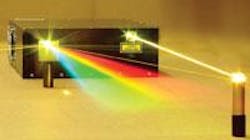CLEO/QELS and PhAST offer something for everyone
Whether you’re a researcher, engineer, or manager interested in the application of lasers and optoelectronics to materials processing, defense and security, medicine, communications, computing, metrology, sensing, or illumination and displays, chances are there was something for you at the 2005 Conference on Lasers and Electro-Optics/Quantum Electronics and Laser Science Conference (CLEO/QELS; May 22−27, Baltimore, MD; see figure). For the second year in a row the Photonic Applications, Systems, and Technologies (PhAST) program was held in conjunction with CLEO/QELS and is an applications-oriented series of presentations that complements the historically theoretical research emphasis of CLEO/QELS.
The variety of conference topics was illustrated by the speaker presentations at the plenary sessions, which were divided into separate Monday evening and Wednesday morning sessions. On Monday evening, Arpad Bergh, president of the Optoelectronics Industry Development Association (OIDA; Washington, D.C.), discussed how the convergence of communications, computers, and consumer electronics will lead to new optoelectronics markets and a surge in light-emitting-diode and sensor demand for cell phones, optical data storage, optical interconnects, and flat-panel displays. He noted that countries such as Japan and Taiwan are leaders in broadband deployment because of committed government investment and that the United States will continue to fall seriously behind unless investment dollars are increased. The Monday plenary concluded with a presentation by Shuji Nakamura of the University of California at Santa Barbara (UCSB; Santa Barbara, CA) on one of these emerging growth areas: solid-state lighting for energy-efficient illumination.
In addition to the usual awards ceremony, the Wednesday plenary included a presentation by Christopher Contag of Stanford University (Stanford, CA) showing how optical imaging can reveal the factors that cause stem cells to simply replicate or differentiate into more specialized cells-a timely subject, considering recent controversial news events on embryonic stem-cell funding. And Deborah Jin of JILA and the University of Colorado (Boulder, CO) talked about fermionic condensates-ultracold gases of matter that are enabling researchers to explore fundamental physics phenomena such as superconductivity.
Also representing the variety of conference topics was the mix of paper presentations selected for the Tuesday press luncheon. The growing importance of photonics to medical breakthroughs was highlighted by a presentation, “Applications of time-resolved fluorescence spectroscopy to atherosclerotic cardiovascular disease and brain tumor diagnosis,” by Laura Marcu of Cedars-Sinai Medical Center (Los Angeles, CA). Research into the applicability of slow light to telecommunications and computing was illustrated by Stefan Linden from the Universität Karlsruhe (Karlsruhe, Germany) in his paper “Towards left-handed metamaterials at optical frequencies.”
To provide insight into extreme states of matter inside planets and stars, as well as possible applicability to nuclear-fusion processes, researchers are using ultrafast pulses of laser light to melt metals and other materials in ultrashort time frames to understand their behavior. This research was discussed by R. J. Dwayne Miller of the University of Toronto (Toronto, ON, Canada) in his presentation “Femtosecond electron diffraction: an atomic-level view of condensed phase dynamics,” in which he said that the “camera for the molecular movie” is now in hand. Representative of the increasing number of papers on defense and homeland security was Michael Duncan’s presentation “Sensor fusion for long-range airborne reconnaissance.” Duncan, from the Naval Research Lab (NRL), detailed how monochrome and multispectral/hyperspectral images are being improved and processed using intelligent algorithms to uncover hidden threats to national security.
Nano-optics prominent
Included in the QELS conference was a well-attended (150 people) series of papers on nano-optics, including nanophotonics, resonant-cavity nano-optics, nanoplasmonics, and spectroscopy of nanomaterials, nanoparticles, and single-quantum dots. The PhAST conference also included nano-related presentations. Of particular interest was “Laser processing of polymeric and living biomaterials: how can we leverage nature’s nanotechnology?” by Douglas Chrisey at NRL on how thin films and three-dimensional-biocompatible nanocomposite or photonic crystal “scaffolds” are being used as substrates on which to grow organic tissue layers. PhAST also included an excellent overview of terahertz imaging and its applications by Mark Rosker of the Defense Advanced Research Projects Agency (DARPA), who explored, among other things, how improvements in electronic upconversion and photonic downconversion will be needed for the development of terahertz sources-one component of the overall system required to make terahertz imaging a reality.
Sponsored by the Optical Society of America (OSA; Washington, D.C.), the Institute of Electronic Engineers/Laser and Electro-Optics Society (IEEE/LEOS; Piscataway, NJ), and the American Physical Society’s (APS; College Park, MD) Laser Science Division, the 2005 CLEO/QELS & PhAST conference was attended by 5281 people. The number of papers submitted for the PhAST conference was twice that of last year, perhaps signaling an increasing conference emphasis away from pure research and toward real-world applications of laser and optoelectronic technology.

